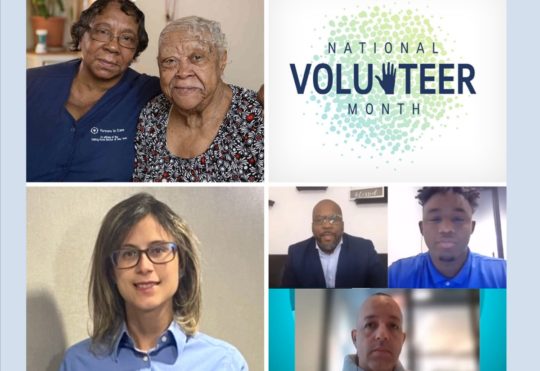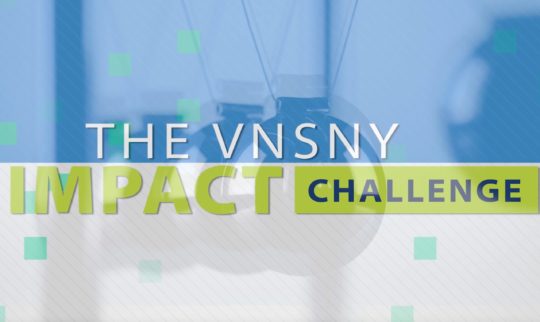An Interview with EVP and Chief Administrative Officer Michael Bernstein
 This past June, Michael Bernstein rejoined VNSNY as EVP and Chief Administrative Officer, with oversight responsibilities for Quality and Customer Experience, Marketing, Development, Communications, Facilities, Administrative Services, ESPRIT Medical Care and the Center for Home Care Policy and Research. Michael previously held key leadership roles at VNSNY from 2005 to 2015, first as Vice President and Chief Marketing Officer and then as Executive Vice President, Business Operations & Chief Marketing Officer.
This past June, Michael Bernstein rejoined VNSNY as EVP and Chief Administrative Officer, with oversight responsibilities for Quality and Customer Experience, Marketing, Development, Communications, Facilities, Administrative Services, ESPRIT Medical Care and the Center for Home Care Policy and Research. Michael previously held key leadership roles at VNSNY from 2005 to 2015, first as Vice President and Chief Marketing Officer and then as Executive Vice President, Business Operations & Chief Marketing Officer.
Welcome back! How would you say the organization has evolved since you were here last?
VNSNY is undergoing a fundamental shift. We have the opportunity today to reinvent how care is brought to the home, in a way that will enable us to be a major player in the New York marketplace. On the provider side, we’ve always been focused on providing patient care for a defined period of time. Now, like the healthcare industry itself, we’re moving to a care management model, in which we also provide ongoing care for patients after the point when they traditionally would have been discharged from home care.
Does this shift include a change in how payers are viewing home care?
Yes. The idea of ongoing care in the home is very powerful, because it’s what people aspire to. No one wants to get their ongoing care in a hospital or nursing home. And VNSNY knows how to provide care in the home—we just have to demonstrate that capability to our payer sources. By working with our own CHOICE Health Plans and other health plan organizations to help people improve their health and well-being and stay out of the hospital, we’ll be providing better care on the human level while also showing payers that their costs can be controlled through our care management services. That’s a big opportunity for the organization.
VNSNY’s new strategic plan includes a focus on improving patient and member experience. Can you share your thoughts on that area?
Quality improvement is vital to the future of our company. This is not a new subject for us, but it’s easier said than done with a workforce as large and decentralized as VNSNY’s, and with a patient and member population made up primarily of elderly, ill individuals. We have to continue driving awareness across VNSNY of how critically important performance metrics are to our organization—from a job satisfaction standpoint, from a patient and member satisfaction standpoint, and from a payment standpoint. It’s no longer enough to pat ourselves on the back and say people appreciate what we do. We have to demonstrate our value in concrete measurements. To do this, we have to build out the number of people at VNSNY dedicated to quality improvement. And across the organization, we have to constantly remind ourselves that quality improvement is part of everyone’s job. I’ll be very focused on those goals.
You’ve mentioned two-way communication within VNSNY as another key priority. Can you explain this?
Another challenge for a large organization like VNSNY, where much of the workforce is out in the field, is to ensure that people understand what the organization is trying to do and that the people developing our programs have the right input from our field staff. We’re committed to two-way communication, and there are many, many efforts now underway to enhance communications with all employees. At the same time, VNSNY staff members need to read the organization’s communications and watch the videos, because there’s a wealth of information there. They also need to ask questions, participate in surveys, and talk to their managers and ask their managers to carry their messages forward. Two-way communication means that sometimes you’re the listener and sometimes you’re the communicator. It’s easy to say “I want people to listen to me,” but you also have to make your voice heard, and there are channels to do that across the organization. Like quality performance, communication is everybody’s responsibility. Nobody gets a free pass on those two things.
What role will external communications play in VNSNY’s strategy?
I’m a great believer in the power of branding and of marketing in general. We’re continuing to make strides in terms of positioning VNSNY externally as the outstanding organization that it is, through tactics like advertising and media relations. We’re also focused on leveraging our Development department, which secures external grants and individual donations to fund important and unique programs like our Nurse-Family Partnership and the Bronx Fatherhood program. And importantly, the VNSNY Center for Home Care Policy and Research is a part of our organization that provides great value to us in terms of both reputation and bringing best insights and best practices to our care delivery.
As Chief Administrative Officer, what are your other areas of focus?
My job includes working with our very strong Facilities team that manages VNSNY’s workspace. Most people who have so far relocated from 1250 Broadway to our new location at 220 East 42nd Street report the move has gone seamlessly, and this is a credit to our Facilities team. Of course, while this major move is underway they also remain very involved in VNSNY’s other locations. Through Administrative Services, I’m responsible for work that touches multiple business lines across the organization, such as contract admin and MD orders. This is work that supports our workflow in ways that aren’t always visible to everybody, but are critically important. The same goes for Safety and Security—often behind the scenes, but certainly important. Finally, I have responsibility for our private medical corporation, ESPRIT Medical Care, which currently delivers services to members of an outside health plan, and is a component of our care management solutions that will be extremely important as we move forward in terms of bringing value to our payers.
As part of a new management team that also knows VNSNY very well, where do you see the organization going?
VNSNY has assembled a leadership team that is committed to the future of the company, and to creating a stable organization that is set on the right long-term course. This is a time to be forward looking. All of our eyes should be turned towards what we can become as an organization over the next five years and beyond—and I’m excited to be a part of that.

